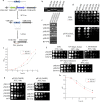SCRaMbLE generates evolved yeasts with increased alkali tolerance
- PMID: 30857530
- PMCID: PMC6410612
- DOI: 10.1186/s12934-019-1102-4
SCRaMbLE generates evolved yeasts with increased alkali tolerance
Abstract
Background: Strains with increased alkali tolerance have a broad application in industrial, especially for bioremediation, biodegradation, biocontrol and production of bio-based chemicals. A novel synthetic chromosome recombination and modification by LoxP-mediated evolution (SCRaMbLE) system has been introduced in the synthetic yeast genome (Sc 2.0), which enables generation of a yeast library with massive structural variations and potentially drives phenotypic evolution. The structural variations including deletion, inversion and duplication have been detected within synthetic yeast chromosomes.
Results: Haploid yeast strains harboring either one (synV) or two (synV and synX) synthetic chromosomes were subjected to SCRaMbLE. Seven of evolved strains with increased alkali tolerance at pH 8.0 were generated through multiple independent SCRaMbLE experiments. Various of structural variations were detected in evolved yeast strains by PCRTag analysis and whole genome sequencing including two complex structural variations. One possessed an inversion of 20,743 base pairs within which YEL060C (PRB1) was deleted simultaneously, while another contained a duplication region of 9091 base pairs in length with a deletion aside. Moreover, a common deletion region with length of 11,448 base pairs was mapped in four of the alkali-tolerant strains. We further validated that the deletion of YER161C (SPT2) within the deleted region could increase alkali tolerance in Saccharomyces cerevisiae.
Conclusions: SCRaMbLE system provides a simple and efficient way to generate evolved yeast strains with enhanced alkali tolerance. Deletion of YER161C (SPT2) mapped by SCRaMbLE can improve alkali tolerance in S. cerevisiae. This study enriches our understanding of alkali tolerance in yeast and provides a standard workflow for the application of SCRaMbLE system to generate various phenotypes that may be interesting for industry and extend understanding of phenotype-genotype relationship.
Keywords: Alkali tolerance; SCRaMbLE; SPT2; Saccharomyces cerevisiae; Synthetic biology.
Figures




Similar articles
-
Ring synthetic chromosome V SCRaMbLE.Nat Commun. 2018 Sep 17;9(1):3783. doi: 10.1038/s41467-018-06216-y. Nat Commun. 2018. PMID: 30224715 Free PMC article.
-
SCRaMbLE-in: A Fast and Efficient Method to Diversify and Improve the Yields of Heterologous Pathways in Synthetic Yeast.Methods Mol Biol. 2020;2205:305-327. doi: 10.1007/978-1-0716-0908-8_17. Methods Mol Biol. 2020. PMID: 32809206
-
Precise control of SCRaMbLE in synthetic haploid and diploid yeast.Nat Commun. 2018 May 22;9(1):1933. doi: 10.1038/s41467-018-03084-4. Nat Commun. 2018. PMID: 29789567 Free PMC article.
-
Probing eukaryotic genome functions with synthetic chromosomes.Exp Cell Res. 2020 May 1;390(1):111936. doi: 10.1016/j.yexcr.2020.111936. Epub 2020 Mar 9. Exp Cell Res. 2020. PMID: 32165165 Review.
-
Discovering and genotyping genomic structural variations by yeast genome synthesis and inducible evolution.FEMS Yeast Res. 2020 Mar 1;20(2):foaa012. doi: 10.1093/femsyr/foaa012. FEMS Yeast Res. 2020. PMID: 32188997 Review.
Cited by
-
The Role of Structural Variation in Adaptation and Evolution of Yeast and Other Fungi.Genes (Basel). 2021 May 8;12(5):699. doi: 10.3390/genes12050699. Genes (Basel). 2021. PMID: 34066718 Free PMC article. Review.
-
Establishment of a Cre-loxP System Based on a Leaky LAC4 Promoter and an Unstable panARS Element in Kluyveromyces marxianus.Microorganisms. 2022 Jun 17;10(6):1240. doi: 10.3390/microorganisms10061240. Microorganisms. 2022. PMID: 35744758 Free PMC article.
-
Mobile Translation Systems Generate Genomically Engineered Escherichia coli Cells with Improved Growth Phenotypes.ACS Synth Biol. 2022 Sep 16;11(9):2969-2978. doi: 10.1021/acssynbio.2c00099. Epub 2022 Aug 11. ACS Synth Biol. 2022. PMID: 35951371 Free PMC article.
-
Origin, Regulation, and Fitness Effect of Chromosomal Rearrangements in the Yeast Saccharomyces cerevisiae.Int J Mol Sci. 2021 Jan 14;22(2):786. doi: 10.3390/ijms22020786. Int J Mol Sci. 2021. PMID: 33466757 Free PMC article. Review.
-
Investigation of Genome Biology by Synthetic Genome Engineering.Bioengineering (Basel). 2023 Feb 20;10(2):271. doi: 10.3390/bioengineering10020271. Bioengineering (Basel). 2023. PMID: 36829765 Free PMC article. Review.
References
MeSH terms
Substances
Grants and funding
LinkOut - more resources
Full Text Sources
Other Literature Sources
Molecular Biology Databases

